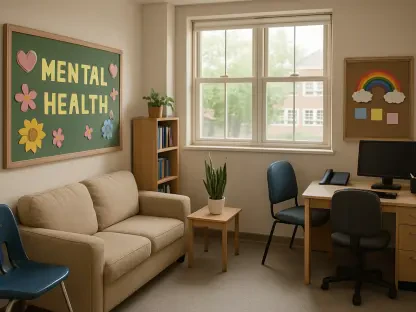The Fargo School Board’s recent decision to approve the budget for the 2025-26 school year has sparked widespread concern across the community, as Fargo Public Schools faces a troubling pattern of multi-million dollar deficits for the second consecutive year. With a projected shortfall of $2.5 million looming for 2026, on top of deficits amounting to $4.5 million in the current year and over $2 million in the prior year, the district finds itself at a critical financial juncture. This pressing issue, brought to light during a board meeting on September 23, casts a spotlight on the challenges of balancing educational quality with fiscal responsibility. As stakeholders grapple with these numbers, the central question emerges: what strategies will the district employ to navigate this deficit while ensuring that students and staff are not adversely affected by potential cuts or reallocations? This discussion sets the stage for a deeper exploration into the financial realities, strategic responses, and future outlook for Fargo Public Schools.
Examining the Financial Landscape
The newly approved budget for the 2025-26 school year stands at a substantial $213.2 million, with the general operating fund comprising $198 million of that total, marking a slight increase from the previous year’s allocations. Despite this incremental growth, Chief Financial Officer Jackie Gapp has underscored the persistent challenge of deficits that continue to plague the district’s finances. Even when accounting for all available revenue streams, the shortfall remains a stark reality, driven by escalating operational costs and ongoing commitments that exceed incoming funds. This financial snapshot reveals a district under pressure, where the numbers highlight the urgency of addressing systemic imbalances. The situation demands not just acknowledgment but actionable steps to prevent further erosion of fiscal stability, as the gap between expenditure and income continues to widen with each passing year, posing risks to long-term planning and resource allocation for educational programs.
Beyond the raw figures, the broader implications of this budget paint a picture of a district at a crossroads, forced to reconcile ambitious educational goals with the harsh constraints of limited resources. The increase in the budget, while seemingly positive, masks the underlying issue of deficits that threaten to undermine the district’s ability to sustain current levels of service and support for students. This financial strain is not merely a numbers game but a reflection of deeper structural challenges, including rising costs in staffing, facilities, and technology, which are essential for maintaining a competitive educational environment. As Fargo Public Schools navigates this terrain, the focus must shift toward identifying inefficiencies and exploring innovative revenue solutions without compromising the quality of education. The board’s approval of this budget, while necessary, serves as a reminder that temporary measures will not suffice, and a more robust strategy is imperative to secure the district’s financial future.
Addressing Sustainability Challenges
A predominant concern echoing through the Fargo School Board is the long-term sustainability of operating with consecutive deficit budgets, a trend that could jeopardize the district’s financial health if left unchecked. Greg Clark, chair of the planning committee, has voiced apprehension about the current trajectory, noting that while the district’s fund balance—currently at the minimum policy threshold of 15%—can cover the immediate shortfall without the need to borrow for payroll, this approach is far from sustainable. Clark has warned that delaying action on this issue could lead to drastic budget cuts ranging from 5% to 10% in the coming years, a far cry from the modest 1% adjustment that could suffice if acted upon now. This perspective emphasizes the importance of preemptive measures to avert a more severe fiscal crisis, highlighting the delicate balance between maintaining services and ensuring financial prudence.
Adding to the discourse, Board Vice President Robin Nelson has expressed significant unease about the district’s financial position, casting the sole dissenting vote against the budget approval to draw attention to her deep concerns. Her stance is not rooted in immediate panic but in a desire to underscore the risks of operating so close to the financial edge, with the fund balance at its lowest acceptable limit. Nelson’s vote serves as a symbolic gesture, urging the board and administration to prioritize resolving the deficit rather than accepting it as a manageable norm within policy constraints. This dissent reflects a broader sentiment that even if the current situation is not dire, the trend of deficits signals a need for heightened vigilance and corrective action. The combination of Clark’s pragmatic warnings and Nelson’s principled stand illustrates a shared recognition of the problem, albeit with differing emphases on timing and approach to finding a lasting solution for Fargo Public Schools.
Strategic Directions Under New Leadership
Stepping into this complex financial landscape is Cory Steiner, the newly appointed superintendent of Fargo Public Schools, who assumed the role earlier this year and brings a fresh perspective to the challenge of deficit reduction. Steiner has wasted no time in initiating a comprehensive review of the district’s operations, scrutinizing areas such as staffing levels, subscription costs, licensing fees, and student programs to identify potential savings. His approach is grounded in aligning expenditures with the core values of the district, ensuring that any cuts or reallocations do not undermine the educational mission. By prioritizing collaboration and engaging staff in these discussions, Steiner aims to foster a sense of shared responsibility and transparency in decision-making, which could pave the way for innovative solutions to emerge from within the district’s own ranks, addressing the deficit through internal efficiencies.
Furthermore, Steiner’s leadership signals a shift toward a more proactive and operational focus in tackling financial challenges, distinguishing his strategy from mere budgetary adjustments. This involves not just trimming costs but reevaluating how resources are utilized to maximize impact on student outcomes, a critical consideration given the constraints posed by the current deficit. His commitment to involving stakeholders in the process reflects an understanding that sustainable change requires buy-in from those directly affected by budget decisions, including teachers, administrators, and support staff. As Fargo Public Schools embarks on this journey under Steiner’s guidance, the emphasis on operational analysis offers a glimmer of hope that systemic issues can be addressed without resorting to drastic measures that might compromise educational quality. This strategic pivot under new leadership could prove pivotal in steering the district toward a more stable financial footing over time.
Revenue Opportunities and Positive Developments
Amid the sobering financial outlook, a notable positive development emerges in the form of tax revenue growth, which offers a potential lifeline for Fargo Public Schools as it contends with persistent deficits. Unlike previous years when revenue increases were driven by spikes in property valuations, the projected rise of over 4% for the 2025-26 school year is attributed primarily to new properties being added to the tax rolls in Fargo. Chief Financial Officer Jackie Gapp has highlighted this as a healthier source of revenue, as it broadens the tax base without placing additional burdens on existing property owners through higher rates. This growth presents an opportunity for the district to bolster its financial resources naturally, providing a buffer that could help mitigate the impact of the deficit if strategically managed alongside other cost-saving initiatives.
This revenue uptick, while encouraging, also prompts a broader discussion on how such funds should be prioritized to address the district’s most pressing needs without becoming a crutch for deeper structural issues. The addition of new properties to the tax base reflects community growth, which, while beneficial, also increases demand for educational services, potentially offsetting some of the financial gains if not carefully planned. Fargo Public Schools must consider how to leverage this revenue stream to support sustainable budgeting practices, perhaps by allocating a portion to rebuild the fund balance beyond the minimum threshold or investing in long-term cost-saving measures like energy-efficient infrastructure. This positive trend, though not a complete solution, underscores the importance of diversifying income sources and aligning revenue growth with strategic fiscal goals to ensure that temporary relief translates into enduring stability for the district.
Unified Concerns and Varied Approaches
Across the Fargo School Board and district administration, there exists a clear consensus that the ongoing trend of deficits poses a significant long-term risk to financial stability, even if the immediate situation remains manageable due to the existing fund balance. Board members and officials alike acknowledge that consecutive shortfalls, while not yet catastrophic, cannot be ignored without consequence. Greg Clark advocates for swift, minor corrections to prevent the need for harsher cuts in the future, emphasizing fiscal discipline as a cornerstone of the district’s response. His perspective prioritizes urgency, aiming to address the deficit before it spirals into a larger problem that could disrupt educational services and staff morale in Fargo Public Schools, reflecting a pragmatic approach to financial stewardship.
In contrast, Robin Nelson’s dissenting vote against the budget serves as a symbolic reminder to keep the deficit at the forefront of the district’s agenda, even as she expresses cautious optimism in the new superintendent’s ability to steer the course. Her approach highlights the importance of maintaining a critical dialogue around financial health, ensuring that complacency does not set in despite the current capacity to absorb shortfalls. Meanwhile, Cory Steiner’s focus on operational reviews and staff engagement introduces a practical dimension to the conversation, suggesting that solutions may lie in reevaluating internal processes and fostering collaboration. These varied approaches—ranging from immediate action to symbolic dissent and operational reform—collectively illustrate a district united in its concern over deficits but diverse in its methods for achieving fiscal recovery, setting the stage for a multifaceted strategy moving forward.
Charting the Path Forward
Reflecting on the discussions that unfolded during the Fargo School Board meeting, it became evident that the approval of the 2025-26 budget marked a pivotal moment for the district, highlighting both the challenges and the resolve to overcome them. The persistent deficits, while manageable in the short term, underscored a need for vigilance and strategic planning that had been acknowledged by all stakeholders involved. Looking ahead, Fargo Public Schools must capitalize on the momentum generated by new leadership and positive revenue trends to implement sustainable changes. Prioritizing operational efficiencies, rebuilding the fund balance beyond the minimum threshold, and strategically allocating new tax revenues could serve as foundational steps toward fiscal health. Additionally, fostering continued collaboration among board members, staff, and the community will be essential in crafting solutions that preserve educational quality. As the district navigates these financial waters, the commitment to proactive measures lays a promising groundwork for stability in the years to come.









